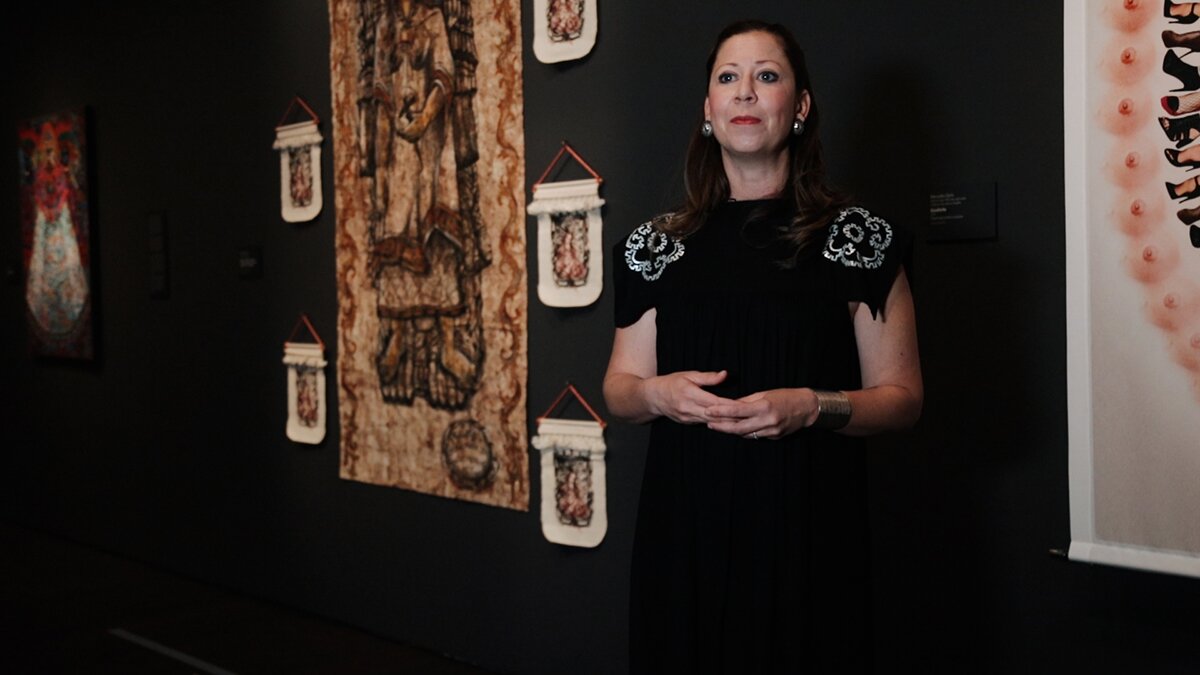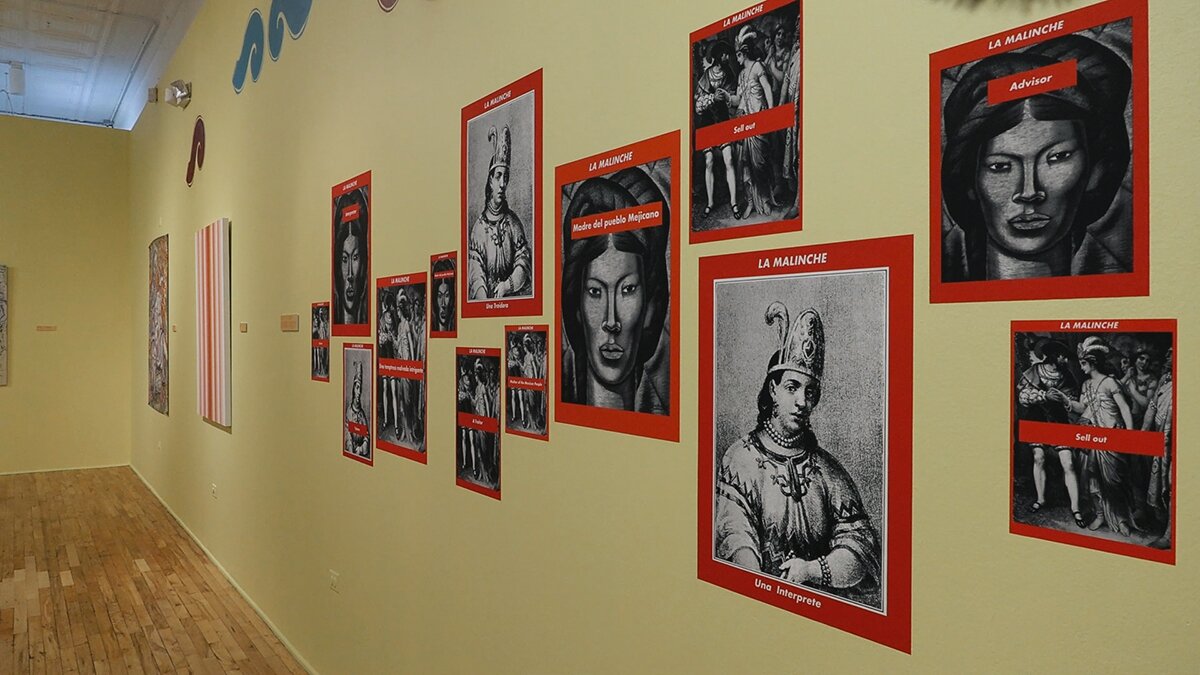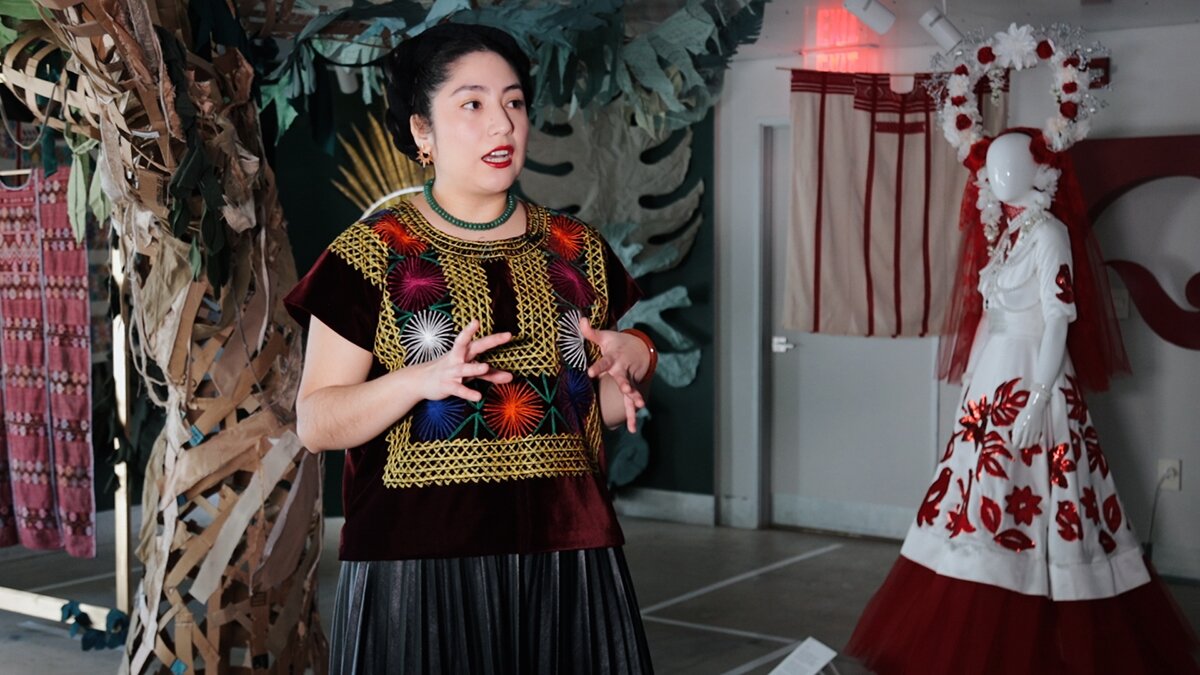How 3 Denver exhibits are honoring one of Latin America’s most controversial women

DENVER — Across the city, three art exhibitions are working to provide education and unpack the controversial story of Malintzin. Also known as La Malinche, Malinalli, Doña Marina and many other names, Malintzin was an Indigenous woman who served as Hernán Cortés’ translator during many of his expeditions, including the Spanish-Aztec war of the early 1500s.
For the past 500 years, Malintzin has often been portrayed as a traitor and a villain who helped Cortés colonize Mexico and murder thousands of the Indigenous people living there. Through their exhibition “Traitor, Survivor, Icon: The Legacy of La Malinche,” the Denver Art Museum (DAM) aims to provide a different perspective on Malintzin’s story, one that contradicts the westernized and male-dominated narrative often associated with her name.
“Our exhibition is not a neutral reexamination of Malinche … we've always been really clear that we're 100% team Malinche and we offer a very positive reading and reinterpretation of her life story based on these historical fragments,” said Victoria Lyall, the Jan and Frederick Mayer curator of art of the ancient Americas at DAM and one of the curators of the Malinche exhibit.
The exhibition, which Lyall and her co-curator Terezita Romo have been working on for six years, follows an essay Romo wrote in 1999 titled “Malinche as Metaphor.” The essay and exhibition both begin with what remains of the historical records of Malintzin’s life.
Malintzin, the daughter of an Aztec chief, was either captured or sold into slavery in what is now the Tabasco region of Mexico. After defeating the Mayans, who owned Malintzin, Hernan Cortés, the Spanish conquistador responsible for the colonization of Mexico and much of Latin America, was given Malintzin along with 20 other women and various treasures as a reward for his conquest.
When the Spaniards discovered Malintzin’s extensive knowledge of multiple Indigenous languages, Cortés took her as his personal translator and mistress and used her along with one of his men to create a ‘translation chain’ into Spanish. Historians estimate that Malintzin learned Spanish herself within four months, and she was quickly promoted to Cortés’ primary interpreter.
In addition to being a translator and compelling speaker, Malintzin also proved to be a talented strategist capable of forming political connections. With her help, Cortés was able to continue the Spanish colonization of Mexico and broker the alliances he needed to overthrow the Aztec empire.
Over the rest of her life, Malintzin accompanied Cortés on multiple expeditions and became a powerful and important figure in history. In addition, she birthed multiple children, one of whom was Cortés’ first born son, Martin. Malintzin died around the year 1529 of smallpox; she was not even 30 years old.
One of the most important things to note about Malintzin’s story, Lyall says, is that nowhere in the historical record are there any of Malintzin’s own words — only secondhand accounts. With no first-hand perspective to learn from, historians have interpreted Malintzin’s story in different ways, often painting Malintzin as a villain and a traitor.

“Many people think about Malinche as a woman; Well, if you use that term, it implies age and agency, and it divorces you from the reality, which is that she was an enslaved girl without any voice or any vote,” Lyall said. “So the idea that Malinche is a traitor to her people is the idea that … she was a woman with a certain amount of sexual maturity who could seduce men to bend to her will.”
In reality, Malintzin was only in her teens when she was given to Cortés, and as a slave, it is unlikely she had any real agency or will in what happened to her. Regardless, the interpretation of Malintzin as a villain has become popular in Mexican culture over the last five centuries.
Throughout history, Malintzin is often regarded as the Indigenous woman from which all Mexicans descend because her and Cortés’ son, Martin, is hailed as the first “mestizo,” or an individual who is a mix of Indigenous and Spanish heritage. Through being viewed as the mother of all mestizos, Lyall said, Malintzin is seen as the Mexican Eve, with Cortés playing the role of Adam.
In Malintzin’s story, the original sin of eating the apple in the Garden of Eden is instead her perceived betrayal of her own people by helping Cortés. Popular artists and authors perpetuated the vision of Malintzin as a villain and a sinner throughout history.
[Related: Despite similarities, Pocahontas gets love, Malinche gets hate. Why?]
“Octavio Paz, the noted Mexican novelist and Nobel Prize winner, argues that the existential crisis that so many Mexican men felt was due to the fact that they were the descendants of a whore,” Lyall explained. “Malinche is seen as a traitor in his eyes. So he acknowledges the trauma that she suffered, but ultimately blames her for it.”
Eventually the negative image of Malintzin grew more popular; popular enough that one of her alternate names, Malinche, is used as a derogatory term for women who fall outside of societal norms or who choose whiteness over their Mexican roots. Considered by some to be a slur, the term “malinches” or “malinchistas” have been used to describe those who choose not to have children, go to school instead of start a family, or who identify as queer. Some use the terms to mean “traitor,” or to describe individuals who prefer foreign cultures over their own. The use of Malinche’s name in this way sparked a social movement in Chicana culture in the 1970s, wherein women who were often called "malinches" reclaimed the name as something powerful and sacred — an homage to a woman stuck between worlds, an idea many Chicanas can relate to.

“For some Chicanas, the [exhibition] title that features the word ‘Malinche’ and features the word ‘traitor’ has been a trigger,” Lyall said. “Terezita Romo, who is a Chicana curator, really felt strongly that we use the word Malinche in the same spirit of Chicana poets and Chicana artists that reclaimed her.”
“So we use the word Malinche as a way of reclaiming her and saying, ‘Yes, call me a Malinche. Thank you,’” Lyall continued.
“Traitor, Survivor, Icon: The Legacy of La Malinche” is part of the Denver Art Museum’s general admission, and will be showcased through May 8, after which the exhibition will travel to Albuquerque, New Mexico and San Antonio, Texas. The exhibition breaks up Malintzin’s complicated story into five identities associated with her — “La Lengua,” the translator; “La Indígena,” Indigenous woman; “La Madre de Mestizaje,” the mother of a mixed race; “La Traidora,” the traitor; and finally, "Chicana/Contemporary Reclamations.”
“I hope that visitors who go through the whole show will leave with this renewed understanding of the challenges we still have towards Indigenous women and towards Latina women,” Lyall said. “How histories are told through other voices and how important it is that we be responsible for authoring our own story.”
Of the three Malintzin-focused exhibitions currently in Denver, DAM’s exhibit offers the most comprehensive historical perspective of Malinche’s story, but Lyall explained that the exhibit was never intended to be “the final word.”
“We had hoped it would be the beginning of a conversation … [we] were so thrilled when we heard that others were inspired to do their own projects and their own interpretations of Malinche,” Lyall said. “So for us, we're so happy that it's Malinche’s moment in Denver today.”
Coinciding with the DAM’s exhibit is “Malinalli on the Rocks,” another Malintzin-inspired art exhibit put forth by Museo de las Americas in Denver’s Santa Fe Arts District. For the last three decades, the cultural museum has focused on celebrating the artistic and cultural achievements of Latin Americans.

“We are having this conversation about Malinalli because we want to present the local perspective,” Claudia Moran, Museo’s executive director, said. “Local Chicanx and Latinx artists, using different mediums, techniques and styles, want to speak about this archetypical figure.”
One of the artists commissioned for Museo’s exhibition was Denver native Sylvia Montero. She began collaging as a young girl and has nurtured her innate passion for art into a career as a visual and performance artist.
As an Indigenous woman, Montero felt considerable sympathy for Malintzin’s story and life and felt that those who viewed her as a traitor were approaching her story with a very westernized perspective.
“I have incredible compassion for her, and I also just feel incredible strength from her just because her story is still so profound and so still immediate with us today in how she brings hope to other people, other women and people around the world,” Montero said.
Museo’s exhibition presents two of Montero’s artworks. One of the pieces, “They Came on Ships,” was originally created for the 500th anniversary of Christopher Colombus’ arrival in North America.
The piece depicts the Mayan ruins of Chichen Itza with The Virgin of Guadalupe at the forefront and a pre-Columbian statue with the head severed in the background. The piece, Montero explained, is a commentary on the traditional and Indigenous cultures of Latin America dying due to colonialism and Catholicism.
“We have suppressed our cultures for so many years believing that there was this external God that was better than we were, and so [the Virgin] is prevalent in the forefront,” Montero said. “For me, she's just like Malinalli — do we look to her as a savior or as a traitor?”
The last gallery contributing to Malinche’s moment in Denver is the CU Denver Experience Gallery, formerly known as Next Stage gallery. Their exhibition, “Malintzin: Unraveled and Rewoven,” focuses on the importance of textiles and fashion in Malintzin’s story.
“This show is more about having you see her as a person, having you see her as yourself or as part of you and as part of your story and how re-contextualizing certain sections of your own story brings you a lot of peace and brings you a lot of connection with other people,” said Lilian Lara, the artist and curator.
The exhibition seeks to humanize Malintzin through textiles, helping viewers understand the ways in which their story can connect to hers.
One of the most powerful things about textiles, Lara explained, is the common psychological urge viewers have to place themselves in the clothing they see. In the same way someone might imagine themselves in an outfit on a display mannequin in a clothing store, Lara wanted viewers to picture themselves in Malintzin’s clothing.
“Clothing is such a powerful way to communicate who we are, what we stand for, and what our status is at a glance. That was true back then and it’s still true now — the clothing we wear definitely sends a signal of who we are and what we believe in, and so I wanted to create the whole show to kind of illustrate that purpose,” Lara said.

Instead of viewing Malintzin as the traitor she is often presented as, Lara hopes that by humanizing her, people will be able to sympathize with Malintzin’s story. Given the brutality of Cortés and other Spaniards during colonization, it is important to recognize that Malintzin likely saved many lives by encouraging Cortés to lead with dialogue instead of bloodshed. Malintzin being painted as a traitor was one of the driving factors for participating in the exhibit, Lara said.
“And for [Malintzin] to say, ‘I'm going to educate you on how things are done in this country and how things are done on this side of the world so that I can avoid as much bloodshed as possible,’ but then her name [was used to] mean that she [betrayed] her people,” Lara explained. “I think that makes me a little upset and I think is one of the major impetus for working so hard on these shows and for making sure that these shows reach as many people as possible — to change that narrative, to change that context.”
Lara hopes that through her artwork at CU Denver’s Experience Gallery and the exhibitions at the Denver Art Museum and Museo de las Americas, that the narrative around Malintzin will change.
“Maybe in a few years we'll be calling each other ‘malinches’ because of how badass we are, not because we're using it as a derogatory slur,” she said.
Corbett Stevenson is a journalism intern at Rocky Mountain PBS. You can reach her at corbettstevenson@rmpbs.org
Alexis Kikoen is a senior producer at Rocky Mountain PBS. You can reach her at alexiskikoen@rmpbs.org.